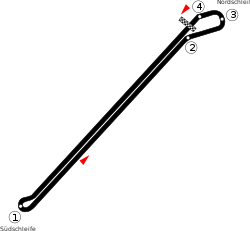Avus North Curve
 |
|
| Location |
|
|---|---|
| Time zone | GMT +1 |
| Major events |
1926 German Grand Prix 1959 German Grand Prix ETCC ('63-'88), Formula 3, DTM, DRM, Interserie, Group C |
| Length | 8.300 (1959 GP) km (5.157 mi) |
| Turns | 4 |
| Race lap record | 2:04.5 (Tony Brooks, Ferrari, 1959) |
The Automobil-Verkehrs- und Übungsstraße ('Automobile traffic and training road'), known as AVUS, is a public road in Berlin, Germany. Opened in 1921, it is the oldest controlled-access highway in Europe. Until 1998, it was also used as a motor racing circuit. Today, the AVUS forms the northern part of the Bundesautobahn 115.
The highway is located in the south-western districts of Berlin, linking the Stadtring at the Funkturm junction in Charlottenburg with Nikolassee. It runs through the Grunewald forest along the historic Königsweg road from Charlottenburg to Potsdam and the parallel Berlin-Blankenheim railway line.
While normal for a road, it is unusually shaped for a race track as it is essentially just two long straights in the form of a dual carriageway, with a hairpin corner at each end. The north curve featured a steep banking from 1937 to 1967. While the original layout was 19 km (12 mi) long, the southern turn was moved several times, to shorten the track to 8.3 km (5.2 mi), then 8.1 km (5.0 mi) without the banking, 4.8 km (3.0 mi) and finally 2.6 km (1.6 mi).
In 1907 the Kaiserlicher Automobilclub (KAC) association devised a fee-financed circuit, as both a motor-sport venue and a testing track for the motor industry. A developing company was established in 1909; however, a lack of finances and official authorisations delayed the start of construction until spring 1913. During the Great War works discontinued, and though Russian Army prisoners were temporarily employed in AVUS's construction, the track was still unfinished. From 1920 the remaining road work was financed by business man and politician Hugo Stinnes. The circuit including a gate building and several stands was inaugurated in the course of the first post-war International Automobile Exhibition (IAA) with a motor race on 24 September 1921. Afterwards the road was open to the public at a charge of ten Marks.
...
Wikipedia
